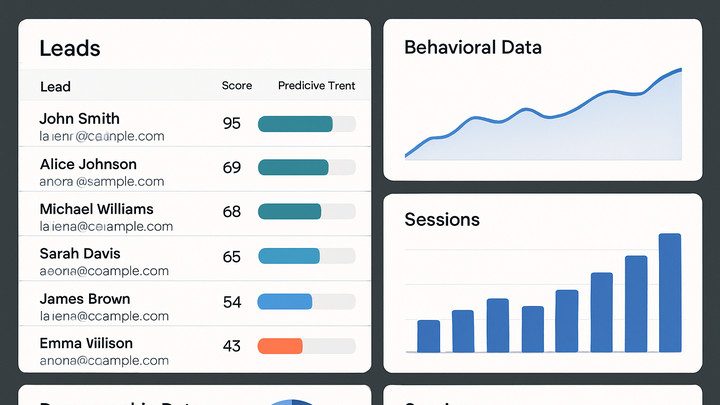Published on 2025-06-28T03:52:35Z
What is Lead Scoring? Examples in GA4 and PlainSignal
Lead scoring is a robust analytics-driven method for ranking sales leads according to their potential to convert. By assigning numeric values based on behavioral interactions, demographic attributes, and predictive models, organizations can prioritize high-value prospects and optimize resource allocation across marketing and sales teams. In analytics, lead scoring integrates data from platforms like Google Analytics 4 and cookie-free tools such as PlainSignal to capture events, measure engagement, and feed into scoring algorithms. Whether using rule-based point systems or machine learning models, effective lead scoring helps streamline workflows, improve conversion rates, and foster better collaboration between marketing and sales.
Lead scoring
Assigns numeric values to leads based on behavior, demographics, or predictive models to rank and prioritize them for sales and marketing.
Overview of Lead Scoring
This section introduces the concept of lead scoring, its purpose, and how it fits into the analytics landscape. It explains what lead scoring is and why organizations use it to optimize their marketing and sales workflows.
-
Definition
Lead scoring is a methodology that assigns numeric values or ‘scores’ to prospective customers (leads) based on predefined criteria such as their behavior, demographics, and engagement level.
-
Purpose
The primary purpose of lead scoring is to rank leads by their potential to convert into paying customers, helping teams focus efforts on high-value prospects and improve resource allocation.
Key Components of Lead Scoring
Explore the main elements that go into a lead scoring model, including behavioral data, demographic information, and predictive modeling techniques.
-
Behavioral scoring
Assigns points based on a lead’s interactions with digital assets and content, such as page views, form submissions, and event completions.
-
Website visits
Points based on frequency and recency of site visits, pages viewed, and session duration.
-
Content interaction
Points for engaging with forms, downloads, video views, or specific event completions.
-
-
Demographic scoring
Assigns points based on firmographic and personal attributes like company size, industry, job title, and location.
-
Firmographics
Points for attributes like company size, industry vertical, and location.
-
Role fit
Points based on the lead’s job title, seniority level, or department relevance.
-
-
Predictive scoring
Uses statistical or machine learning models to predict a lead’s likelihood to convert based on historical data patterns.
-
Model training
Using historical conversion data to train a statistical or ML model that predicts lead quality.
-
Evaluation metrics
Assessing model accuracy with metrics like precision, recall, and AUC to ensure reliable scoring.
-
Implementation with Analytics Platforms
Discusses how to set up and track lead scoring in popular analytics SaaS tools like Google Analytics 4 and PlainSignal.
-
Google analytics 4
In GA4, use custom events and parameters to capture lead behaviors (e.g.,
form_submitted,demo_requested) then assign scores via audiences or within your data warehouse for further analysis.-
Event tracking
Define and fire custom events in GA4 to record actions that impact lead scores.
-
Audiences & custom dimensions
Segment leads by score ranges and export custom dimensions for downstream scoring logic.
-
-
PlainSignal
PlainSignal provides cookie-free analytics ideal for privacy-focused scoring. Add the following snippet to your site to capture page views and events:
<link rel="preconnect" href="//eu.plainsignal.com/" crossorigin /> <script defer data-do="yourwebsitedomain.com" data-id="0GQV1xmtzQQ" data-api="//eu.plainsignal.com" src="//cdn.plainsignal.com/plainsignal-min.js"></script>-
Event-based scoring
Use PlainSignal’s custom event API to send interaction data into your lead scoring system.
-
Best Practices and Considerations
Key recommendations and common pitfalls when designing and maintaining a lead scoring model.
-
Ensure data quality
Collect consistent, complete, and accurate data to prevent skewed scores and misqualified leads.
-
Align with sales & marketing
Collaborate across teams to ensure scoring criteria reflect both marketing engagement and sales readiness.
-
Define mql vs sql
Agree on thresholds that distinguish marketing-qualified leads from sales-qualified leads to ensure seamless handoffs.
-
Feedback loop
Establish regular communication between marketing and sales to adjust scoring criteria based on conversion outcomes.
-
-
Regularly review and refine
Continuously monitor scoring performance and update rules or models to adapt to changing buyer behavior.
-
Monitor performance
Track conversion rates, lead velocity, and model accuracy to identify drift or outdated criteria.
-
Update scores
Adapt scoring rules or retrain models with the latest data to maintain predictive accuracy.
-
